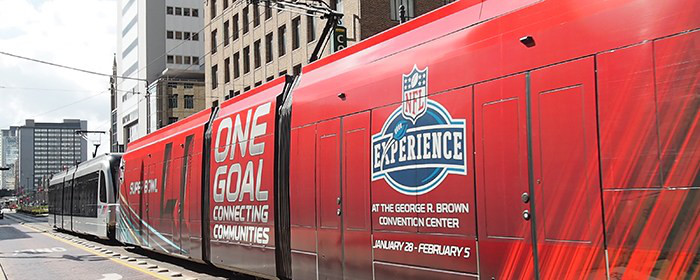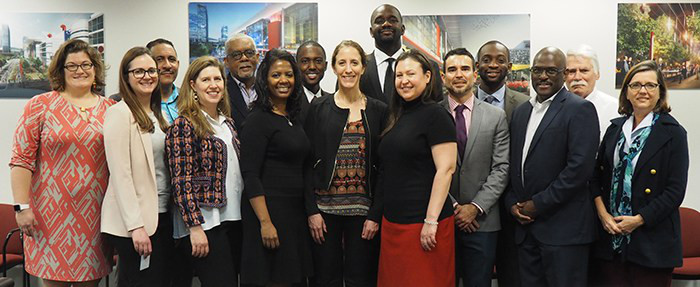An Inside Look at Equitable Economic Development in Houston
This post is part of a series on NLC’s Equitable Economic Development (EED) Fellowship.
We meet one of NLC’s Equitable Economic Development (EED) Fellows, Gwendolyn Tillotson of Houston, and discuss how the city is reaching its most vulnerable communities and increasing their access to employment and job training opportunities.
Carlos Delgado: Gwen, thank you for agreeing to share your insights about Houston and the EED Fellowship. How about a brief introduction?
Gwen Tillotson: Carlos, thank you for this opportunity. It’s been a rewarding experience for the city and for me personally and professionally to be part of this group of economic developers and city leaders. I assumed the role of deputy director of economic development with the mayor’s office on January 7, 2012. Before joining the economic development team, I spent more than six years working for the city of Houston in various roles, beginning my career with the planning and development department.

Gwen Tillotson is the deputy director of economic development for the city of Houston.
That’s an impressive progression with the city of Houston, given your already extensive private sector experience and academic background. Why is an equitable economic development agenda a priority for the city and Mayor Sylvester Turner?
Early on in his administration, Mayor Turner created several task force groups to assess the current “state of city” in several key areas, one of which was economic opportunity. He made it clear it was important that the city not be characterized by “haves” and “have nots,” and that every community should have equal access to resources, programs, opportunities, jobs and related training, infrastructure, quality of life amenities, and other public services needed to reach its fullest potential. That philosophy of access for all has morphed into a full initiative referred to as “Complete Communities.”
This sounds like the perfect time for Houston to be part of the EED Fellowship; our goal is to influence economic development policy and practice so that equity, innovation, transparency, sustainability and community engagement become driving forces on any project with the intentionality to connect underserved communities to economic opportunities.
The invitation to be part of first cohort of EED Fellowship cities could not had arrived at a better time. When we were approached by the National League of Cities (NLC), the Urban Land Institute (ULI) and PolicyLink, the city of Houston — and, specifically, the economic development department — was exploring ways to reach our most vulnerable communities and increase their access to employment and job training opportunities, which would in turn increase their independence and sustainability.
Houston is an amazing city. We are the fourth largest city [in the U.S.], we’re recognized as one of the top cities for corporate relocations, manufacturing and medical, and we’ve been ranked by Forbes as one of the “coolest places to live.” As a city government, we’ve invested millions in our quality of life assets such as parks and trails along our beautiful bayous, which in turn is drawing in a lot of millennials and those desiring a high quality of life at a lower cost of living than on the east or west coasts. We have a lot to be proud of.
However, while Houston has a strong, thriving, dynamic economic climate overall, there is much disparity between the city’s healthiest business centers and our most vulnerable, “high-opportunity” communities. The city’s east and south communities typically have more than 30 percent of their population living below poverty. Through our participation in the EED Fellowship program, we have an opportunity to connect our underrepresented populations with employers, and we have the small business tools to help empower them so that they can not only sustain themselves but begin to thrive. We will only be our best Houston when it is less obvious on which side of the economic spectrum our communities register.

A tram in downtown Houston.
We are thrilled to be working with Houston and your team during this EED Fellowship year, and that the city is intentionally connecting programs, services and resources to communities like those east of downtown who have historically been shortchanged of economic opportunities. What progress you have made since we kicked off the program?
We began by recognizing the need to address economic inequities, which means identifying and mitigating barriers to employment and other resources, improving connectivity between employers and residents to better align new jobs with existing skill sets, and focusing on educational attainment to meet immediate job needs. Then, we recognized we must work in collaboration with other partners to help develop skills within a community’s workforce that could lead to more gainful and sustainable employment.
UpSkills Houston, an active regional workforce initiative, seeks to close the skills gap by increasing the number of people trained for middle-skill careers, and we see our CREST (Creating Reliable Employment for Sustainable Tomorrows) program as providing the first line of jobs that could “feed” into the UpSkills Program. With CREST, we are exploring a targeted hiring program that will help to ease the cost to employers associated with hiring employees within specific communities that may require some job training. The program will partner with workforce agencies, employers and community nonprofits to provide needed resources and connectivity for residents to gain meaningful employment. Also, improving access to technical, business and capital resources needed to start or grow small businesses is of equal priority in this program.
We assessed our inventory of current economic development programs and tools to determine which might be the most appropriate to meet the EED objective, which is to provide access to income and wealth to communities of the greatest need, given the fact that those communities have not historically attracted major development projects. Given Houston’s massive land availability (634 square miles), which is not controlled by zoning, growth in those communities is not likely in the immediate future without some program to intentionally drive development into those communities. Because of Houston’s large geographical footprint, we decided to focus the proposed EED project in the East End as a pilot, with the goal of availing this program to other communities once the structure is defined.
We have also convened a business attraction committee and a small business committee that represents community and nonprofit agencies, academia, chambers of commerce, government and the private business communities. Through these committees, we defined two essential components to job access. The first focuses on using existing programs to attract companies with primarily low- to mid-skill job requirements, consistent with the current educational attainment and skill sets of the existing target population. The second component looks at target hiring through an incentive program that could provide existing companies within roughly five to seven miles of East End property, with a “per-job” incentive if they hire from the East End. Finally, we added the development of a small business portal to provide a single source for information and resources necessary to start and register a business or grow an existing small business.
It looks like you’re making great progress with the project and identifying key partners — and partnerships are critical to making a long-term sustainable impact in your focus communities. Can you expand on the stakeholders and partners you have convened to successfully achieve your EED project outcomes?
Our stakeholder groups include so many partners: Rice University, the University of Houston, the U.S. Census Bureau, the Port of Houston, Workforce Solutions, and several community chambers of commerce and economic development agencies, just to name a few. What’s important to note is that we’ve found all our partners are eager to participate and excited that the city of Houston is taking on this leadership role to bring key partners together to connect their aggregate resources to the people who need it.
Part of the EED Fellowship focuses on providing cities with technical assistance site visits. Can you comment about the experience of hosting our Technical Advisory team and how you try to execute their recommendations?
The technical assistance visit was very timely and helpful, not only to review our progress but also to identify additional opportunities and challenges associated with gaps of information or uncertainty about the direction we should proceed, given the multiple dynamics that the project was taking on. The NLC team spent considerable time with the local fellows and met with each stakeholder group separately to obtain their unbiased and direct perspective on the project goals and deliverables and the progress made so far.
Your team provided high-level considerations to enhance community benefit beyond jobs and work-related opportunities, but also offered thoughts on broader development issues such as retail gentrification, the lack of health services, food and merchandise retail, and improved pedestrian infrastructure such as sidewalks, lighting and gathering spaces, which create a sense of identity.
A few of their key recommendations included: defining areas with the greatest potential and/or need to use existing incentive programs as “carrots” for developers to encourage specific types of development, using Chapter 380 to create opportunities for hard-to-employ individuals and families, identifying existing cultural assets such as murals and art centers that capture the neighborhood essence and target development and infrastructure around these assets, and exploring the creation of a kitchen, retail and other types of incubator programs to help existing businesses scale up.
These were excellent recommendations, and our EED Fellowship project will focus its efforts on attracting businesses to the East End to provide much-needed jobs to the community. The Houston EED team is evaluating a web portal to bring together needed information, resources and programs under a single application, and we’re working with our small business partners to ensure that their programs and tools are being connected to this portal. The mayor has also convened a task force to help grow the innovation and tech ecosystem here — and in fact, the East End area has already started attracting very impressive business incubators and co-making/co-working companies, which in turn are attracting innovation and tech small businesses. The idea is to leverage that momentum into an innovation district and tech cluster — and our existing inventory of old warehouses and industrial spaces is ideal for that.
Overall, this wonderful experience with the EED Fellowship has completely altered my perspective of economic development to be more inclusive of all communities, and I recognize now that economic development is a fluid mechanism, and that it has to fit the current status of the community. While I certainly believe it is imperative to bring in large investments with substantial job creation at the higher salary levels to continue to strengthen and grow the economy, I also have a better appreciation that not all communities are positioned to attract large headquarters, professional buildings and manufacturing facilities — but that all communities have assets that can be leveraged to advance their economy towards sustainability.

Visiting fellows, visiting advisors, EED program staff and host city fellows in Houston.
Houston is one of six cities participating in this year’s EED fellowship. View the blog series for more stories and experiences from other fellows.



